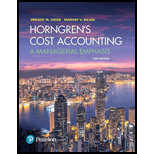1 The Manager And Management Accounting 2 An Introduction To Cost Terms And Purposes? 3 Cost—volume—profit Analysis? 4 Job Costing? 5 Activity-based Costing And Activity-based Management? 6 Master Budget And Responsibility Accounting? 7 Flexible Budgets, Direct-cost Variances, And Management Control? 8 Flexible Budgets, Overhead Cost Variances, And Management Control? 9 Inventory Costing And Capacity Analysis? 10 Determining How Costs Behave? 11 Decision Making And Relevant Information? 12 Strategy, Balanced Scorecard, And Strategic Profitability Analysis? 13 Pricing Decisions And Cost Management? 14 Cost Allocation, Customer-profitability Analysis, And Sales-variance Analysis? 15 Allocation Of Support-department Costs, Common Costs, And Revenues? 16 Cost Allocation: Joint Products And Byproducts? 17 Process Costing? 18 Spoilage, Rework, And Scrap? 19 Balanced Scorecard: Quality And Time? 20 Inventory Management, Just-in-time, And Simplified Costing Methods? 21 Capital Budgeting And Cost Analysis? 22 Management Control Systems, Transfer Pricing, And Multinational Considerations? 23 Performance Measurement, Compensation, And Multinational Considerations expand_more
Chapter Questions expand_more
Problem 7.1Q: What is the relationship between management by exception and variance analysis? Problem 7.2Q: What are two possible sources of information a company might use to compute the budgeted amount in... Problem 7.3Q: Distinguish between a favorable variance and an unfavorable variance. Problem 7.4Q: What is the key difference between a static budget and a flexible budget? Problem 7.5Q: Why might managers find a flexible-budget analysis more informative than a static-budget analysis? Problem 7.6Q: Describe the steps in developing a flexible budget. Problem 7.7Q: List four reasons for using standard costs. Problem 7.8Q: How might a manager gain insight into the causes of a flexible-budget variance for direct materials? Problem 7.9Q: List three causes of a favorable direct materials price variance. Problem 7.10Q: Describe three reasons for an unfavorable direct manufacturing labor efficiency variance. Problem 7.11Q: How does variance analysis help in continuous improvement? Problem 7.12Q: Why might an analyst examining variances in the production area look beyond that business function... Problem 7.13Q Problem 7.14Q: When inputs are substitutable, how can the direct materials efficiency variance be decomposed... Problem 7.15Q: Benchmarking against other companies enables a company to identify the lowest-cost producer. This... Problem 7.16MCQ: Metal Shelf Companys standard cost for raw materials is 4.00 per pound and it is expected that each... Problem 7.17MCQ: All of the following statements regarding standards are accurate except: a. Standards allow... Problem 7.18MCQ: Amalgamated Manipulation Manufacturings (AMM) standards anticipate that there will be 3 pounds of... Problem 7.19MCQ: Atlantic Company has a manufacturing facility in Brooklyn that manufactures robotic equipment for... Problem 7.20MCQ: Basix Inc. calculates direct manufacturing labor variances and has the following information: Actual... Problem 7.21E: Flexible budget. Sweeney Enterprises manufactures tires for the Formula I motor racing circuit. For... Problem 7.22E: Flexible budget. Bryant Companys budgeted prices for direct materials, direct manufacturing labor... Problem 7.23E: Flexible-budget preparation and analysis. Bank Management Printers, Inc., produces luxury checkbooks... Problem 7.24E: Flexible budget, working backward. The Clarkson Company produces engine parts for car manufacturers.... Problem 7.25E: Flexible-budget and sales volume variances. Cascade, Inc., produces the basic fillings used in many... Problem 7.26E: Price and efficiency variances. Sunshine Foods manufactures pumpkin scones. For January 2017, it... Problem 7.27E: Materials and manufacturing labor variances. Consider the following data collected for Great Homes,... Problem 7.28E: Direct materials and direct manufacturing labor variances. Rugged Life, Inc., designs and... Problem 7.29E: Price and efficiency variances, journal entries. The Schuyler Corporation manufactures lamps. It has... Problem 7.30E: Materials and manufacturing labor variances, standard costs. Dawson, Inc., is a privately held... Problem 7.31E: Journal entries and T-accounts (continuation of 7-30). Prepare journal entries and post them to T... Problem 7.32E: Price and efficiency variances, benchmarking. Nantucket Enterprises manufactures insulated cold... Problem 7.33E: Static and flexible budgets, service sector. Student Finance (StuFi) is a start-up that aims to use... Problem 7.34P: Flexible budget, direct materials, and direct manufacturing labor variances. Emerald Statuary... Problem 7.35P: Variance analysis, nonmanufacturing setting. Joyce Brown has run Medical Maids, a specialty cleaning... Problem 7.36P: Comprehensive variance analysis review. Ellis Animal Health, Inc., produces a generic medication... Problem 7.37P: Possible causes for price and efficiency variances. You have been invited to interview for an... Problem 7.38P: Material-cost variances, use of variances for performance evaluation. Katharine Johnson is the owner... Problem 7.39P: Direct manufacturing labor and direct materials variances, missing data. (CMA, heavily adapted)... Problem 7.40P: Direct materials efficiency, mix, and yield variances. Sandys Snacks produces snack mixes for the... Problem 7.41P: Direct materials and manufacturing labor variances, solving unknowns. (CPA, adapted) On May 1, 2017,... Problem 7.42P: Direct materials and manufacturing labor variances, journal entries. Collegiate Corn Hole is a small... Problem 7.43P: Use of materials and manufacturing labor variances for benchmarking. You are a new junior accountant... Problem 7.44P: Direct manufacturing labor variances: price, efficiency, mix, and yield. Elena Martinez employs two... Problem 7.45P: Direct-cost and selling price variances. MicroDisk is the market leader in the Secure Digital (SD)... Problem 7.46P: Variances in the service sector. Derek Wilson operates Clean Ride Enterprises, an auto detailing... Problem 7.47P format_list_bulleted


 College Accounting, Chapters 1-27AccountingISBN:9781337794756Author:HEINTZ, James A.Publisher:Cengage Learning,
College Accounting, Chapters 1-27AccountingISBN:9781337794756Author:HEINTZ, James A.Publisher:Cengage Learning, College Accounting, Chapters 1-27 (New in Account...AccountingISBN:9781305666160Author:James A. Heintz, Robert W. ParryPublisher:Cengage Learning
College Accounting, Chapters 1-27 (New in Account...AccountingISBN:9781305666160Author:James A. Heintz, Robert W. ParryPublisher:Cengage Learning Survey of Accounting (Accounting I)AccountingISBN:9781305961883Author:Carl WarrenPublisher:Cengage LearningPrinciples of Accounting Volume 2AccountingISBN:9781947172609Author:OpenStaxPublisher:OpenStax College
Survey of Accounting (Accounting I)AccountingISBN:9781305961883Author:Carl WarrenPublisher:Cengage LearningPrinciples of Accounting Volume 2AccountingISBN:9781947172609Author:OpenStaxPublisher:OpenStax College Principles of Cost AccountingAccountingISBN:9781305087408Author:Edward J. Vanderbeck, Maria R. MitchellPublisher:Cengage Learning
Principles of Cost AccountingAccountingISBN:9781305087408Author:Edward J. Vanderbeck, Maria R. MitchellPublisher:Cengage Learning




